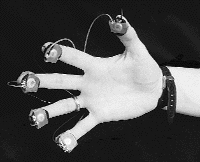
The goal of this work is to convey finger touch and force information (i.e., haptic feedback) to a human operator so (s)he can “feel” what the remote or virtual hand is grabbing. Why is haptic feedback so important?
Numerous human factor studies have shown that our ability to manipulate objects relies heavily on the contact (touch and force) information we gather. Consequently, we are in the process of demonstrating that haptic feedback, even in crude forms, can help a person manipulate remote or virtual objects better than visual feedback alone.
Building a user-transparent tactile feedback system is a difficult research problem, since current and near-term actuator technologies do not provide the fidelity needed to produce realistic sensations. Moreover, these technologies are not sufficiently small and lightweight for a person to wear in a glove. We have opted to use vibrotactile feedback (using vibration to convey information) so that we can have a wearable system. We have developed a vibrotactile glove which uses miniature voice coils (e.g., small audio speakers) to produce vibrations on the wearer’s fingertips and palm.
Our recent work focuses on the best way to modulate the vibration in order to convey information effectively to human users.
past staff
- Pradeep Khosla
- Roberta Klatzky
- Anne Murray
- Karun Shimoga
past contact
- Thomas Gordon